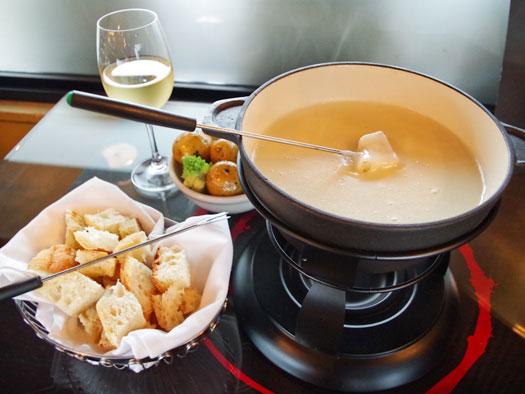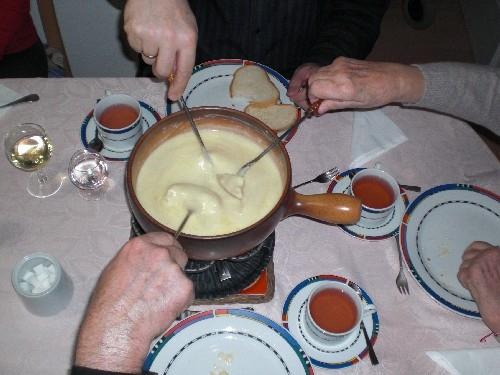Types of fondue cheese
When it comes to the types of Fondue cheese, it is often that Gruyere, Camambert and Fontina are in the foreground and as a combination.
For Switzerland, however, this is related to the territorial-ethnic distinction in the country rather than exhausting the diversity of Fondue types of cheese.
Gruyere comes from the French part of the population – from 7.5 million people in Switzerland, the French are about one fifth. This cheese has been traditionally Swiss for centuries. While Fontina comes from Northern Italy, from its smallest county – Valle d’Aosta. Its full traditions have been there since the 12th century. In Switzerland, it was transferred by the Italian part of the population, which is 700-800 thousand people. There are other more significant features. They replace the wine with milk in which the cheese is melted, and the Fondue itself is called the Fonduta. Butter and yolks are also used for it. Camambert is mainly used in the Normandy parts, dating back to the 18th century.
In practice, under the current conditions in Switzerland as a highly developed and tourist country, each of the options can be found in all parts of the country. In addition, a number of other Fondue cheeses are used. From the Swiss ones, these are Emmentaler (a Swiss trade mark, equivalent to Emmental), the Appenzeller, made for 700 years, Vacherin Fribourgeois which has given the name of a separate Fondue. The Dutch Gauda, French Brie and others are also used.
Among the cheeses used for Fondue there are hard, soft, salty, sweet, moldy, with holes or dense ones, some have a hard rind and are softer on the inside, and so on. The taste sensations are also different – fresh grass, different herbs, fruits, and so on.
Fondue allows for imagination and various combinations according to the tastes that are desired. As it is known, the cheese types that melt into wine for this dish can be one, two or three. If desired, there may be more, but the combination of many tastes has the risk of suppressing and losing some basic qualities of a cheese. So, if one decides to improvise, it is good to first master the basic rules of Fondue preparation.
Characteristics of some of the most popular Swiss Cheeses for Fondue
The name of the Gruyere cheese comes from the Gruyere area, where it is produced. Its cow’s milk production technology is described in a document from 1115.
Since 2001 it has been protected with a controlled origin – cheese can only bear this name if it is produced in certain Swiss cantons. Gruyere is hard, salty and spicy, with a slight flavor of walnuts.
Its appearance is yellow and it’s almost without holes, made in wheels from 24 to 40 kilograms. The strong salty taste is because, as it matures, it is soursed with salt water.
In fact, there are types with a different taste according to the maturation time – 5 months, 7-8 months, 10 months, an year, 15 months. The tastes range from sweet, semi-salty, salty and strongly salty.
Among other popular Fondue cheeses is Emmental, with its Swiss trademark Emmentaler Switzerland. And it is protected with a controlled origin, made in the canton of Bern near the River Eme. Emmentaler also has varieties according to maturation – from 4 to 14 months: Classic, Reserve and Premier Cru. The cheese is sweet, spicy, with a flavor of fruit and walnuts, an aroma like freshly cut grass. The appearance is yellow, dry, smooth, medium-hard, with a paler interior and large holes that are related to the production technology and, more precisely, with the release of air during maturation.
Schabziger has been an officially registered trade mark since 1772; its production technology was recorded shortly after the middle of the 15th century, and it was started in the 8th century by the Glarus monks. It is produced only in the canton of Glarus skimmed cow’s milk and since fenugreek is added, it is greenish. Citric acid, vinegar is also used, can also be added. The cheese is hard, with a strong flavor and taste. It is sold on small wheels weighing 100 grams.
Curious facts about Fondue – eating rules, legends, records
As with any collective activity, and with Fondue, there are rules on how to consume it. They are based in one of the legends about the appearance of this dish.
According to it, it was “discovered” by the Swiss shepherds in the 16th century. They stayed in the mountains for a long time, and as a cure for loneliness, one of the evenings of the week several people gathered together. The evenings in the Alps are cold, and they heated wine in caldrons on the fire.
Their other food and supplies were cheese, which in the course of time dried up, and bread that hardened a lot. So at some point someone thought to melt the cheese in the wine, and dip pieces of the hard bread in the resulting mixture so that they would soften. For the dipping of the bread in the then Fondue long sticks were used, on which the pieces of bread were sticked.
And here came the rules. Since they ate the Fondue from a common pot, every shepherd had to be careful not to ruin his piece of bread or for it not to fall into the common pot. If somone made a mistake, they received 5 hits with a stick. In a case of a second mistake, the hits doubled, in some versions they became 20.
If they messed up for a third time, the others threw him into Lake Geneva with a tied stone on his feet. Especially the latter is not at all certain, but anyway, there are rules. Today – of course – they have nothing to do with hitting with a stick and drowning. Rather, they are a fun game that adds fresh emotions around the fondue. If today somebody drops their piece of bread in the common pot where the dish is, they have to fulfill the wish of each of the company at the table.
There is no data on how these rules have been followed during the attmepst for a record for the largest fondue. In 2008, for example, in a Guinness-record attempt, the Swiss city of Warus made a fondue, which is enough for 950 pots, from which over 3,000 people ate. The used fondue cheeses alone were 1,396.8 kg. Bread was 800 kilograms. The previous record was also Swiss – with fondue of 1,270 kilograms in 1997. Both cases were for charity – they collected funds for children placed in boarding schools.
Fondue types of cheese and health
The Swiss fondue cheeses are unique and very benefitial to health – something that the medical community has strongly emphasized.
It is no coincidence that these cheeses are of a controlled origin, and Emmentaler Switzerland, for example, the trademark of Swiss Emmental, and more precisely its Premier Cru variant, is the winner of the World Cup in the Cheese Industry. It was won in competition with 1,700 types of cheese from all over the world in 2006 in Wisconsin, USA.
The secret of the Swiss Fondue cheeses is in their production technology and in the qualities of the milk itself. Gruyere, for example, is made from unprocessed cow’s milk without the use of preservatives; additives are forbidden in the production. Schabziger is also made of cow’s milk, but skimmed with the addition of blue fenugreek, which contains vitamin C, fibers, protein, potassium, etc. It is useful, for example, for controlling cholesterol, and hence for preventing heart problems. Schabziger contains very little fat – less than 3 percent; it contains no lactose and carbohydrates. In every 100 grams of cheese 33 are proteins.
The Swiss fondue cheeses have calcium, protein, vitamin A, vitamin D. And vitamin B12, in which it is rich, is related to energy absorbtion, blood composition, metabolism, and brain and neurological function. It affects in improving mood, memory, immunity.
The excellent quality of Swiss milk and, respectively, of the Swiss fondue cheeses is based on the type of farming in the country. Dairy farms are not big, they do not chase records in the yield of milk, the production is traditionally environmentally friendly.
For much of the year, cows are grazing freely on pastures that are not cultivated and soils are eco friendly. For winter forage they count on their own ecologically clean production, without the use of chemicals, and thus the excellent material for fondue cheeses is produced.


![[:bg]Популярни сирена за Фондю[:en]Popular cheese in Fondue[:] | Fondue.b](https://fondue.bg/wp-content/uploads/2018/01/popular-fondue-cheese-cover.jpg)



